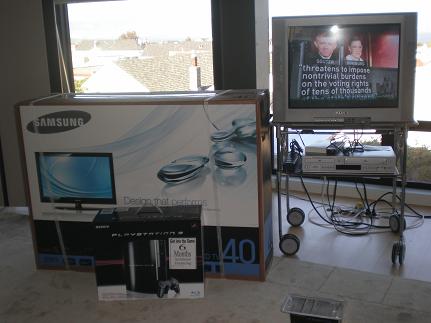My significant domestic other partner's cheap portable cassette player finally broke and SDOP still wanted to listen to music on the go. The default answer is of course an iPod, but remember SPage's law:
any small piece of electronics needs to have a phone in it so you can ring it when (not if!) you lose it
(our digital camera is still lost). So we go to the Sprint store, looking for a top-of-the-line phone. The Sanyo MM-9000 has a miniSD memory card slot, media player, QVGA screen, 1.3 Megapixel camera, and most other reasonable features. SDOP was using the previous top-of-the-line Sanyo SCP-5500 (aka Sprint VM-4500) so the USB cable, and so-so FutureDial Snap software I bought for it might work. The only missing checklist features are Bluetooth, and a 2 Mp camera with optical zoom.
SprintUsers reviews say the camera quality is good. The Samsung A940 is a 2 Mp phone with Bluetooth but the screen is lower res and the camera has to twist around awkwardly.
Sprint was sold out of the phone, so we bought it at Radio Shack. The phone cost $380 plus tax but as the old phone was 22 months old we got a $75 rebate after committing to two more years of Sprint. Then off to Best Buy to buy a SanDisk 1GB miniSD card, SanDisk USB SD card reader, Monster iPod cassette adapter (it actually works with any audio device's 3.5mm stereo headphone jack, which shows you iPod's dominant mindshare), and a 2.5 phone -> 3.5mm headphone adapter cable. We can reuse the old Sanyo's car lighter charger; we still need to get a second battery and a cover. As usual the accessories cost nearly as much as the phone!
To put music on the phone:
- insert music CD into PC
- in iTunes, right-click on desired tracks and choose "Convert Selection to AAC"
Remove miniSD card from phone, insert in SD adapter in SanDisk media reader
just plug in the phone's USB cable and choose "Mass Storage" for the USB Connection
in Windows Explorer, navigate to My Documents\iTunes\iTunes Music, find the track files named .m4a
from iTunes Library view, just drag the tracks you want to the mini SD card's MEDIA folder in Windows Explorer.
Now your phone plays music almost as well as a dedicated 1GB digital audio player. The sound quality is reasonable even through the car adapter (I haven't played around with the audio settings in Edit > Preferences... Advanced > Importing). Every track has a different volume level.
I found out that with
FutureDial's USB drivers the miniSD card appears as a drive letter in Windows, so I don't have to remove the miniSD card from the phone, so the SanDisk USB SD card reader was a waste of money. Just like the SanDisk USB Compact Flash card reader I bought for the digital camera I lost.
The big downside so far is there's no way to play protected music files that we legally own. I've refused to buy songs from the iTunes Music Store on principle, but even their free downloads are
.m4p encrypted files that only work on iPods.
jHymn and
QTFairUse don't work with latest iTunes (donate $50 to DVD Jon to update his
fine work!). This is why DRM (Digital Restrictions Management) is
evil!
So far, it seems like $500 well spent. Then I scanned some more SprintUser forum posts and found out the Sanyo MM-9000 phone is
already obsolete and is going to be discontinued by Sprint!
For my own use I'm still holding out for a flip smartphone with PalmOS PDA functionality + 2Mp camera with optical zoom + MP3 + 4GB expansion card + Infrared + GPS + Bluetooth + WiFi. I held the Samsung sph-i550 in my hand at the Samsung store in NYC, but it's cancelled. "The best is the enemy of the good" (
Voltaire :-)
Categories: electronics, cellphone, music, iPod, DAP, DRM, SanyoMM9000, SprintLabels: cellphone, DRM, electronics, iPod, laws, music, SanyoMM9000, Sprint
 I had held off for years watching the never-ending procession of must-have features that has kept the price of a high-end TV above $3000: 720p, 1080i, 1080p, CCFL backlight, LED backlight, low millisecond response, DVI input, HDMI input, 120 Hz refresh, OLED...
I had held off for years watching the never-ending procession of must-have features that has kept the price of a high-end TV above $3000: 720p, 1080i, 1080p, CCFL backlight, LED backlight, low millisecond response, DVI input, HDMI input, 120 Hz refresh, OLED...
